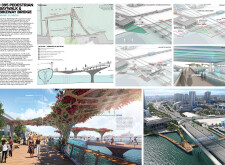5 key facts about this project
## Project Overview
The I-395 Pedestrian Baywalk & Bikeway Bridge, located in Miami, Florida, serves as a multimodal pathway integrating pedestrian walkways and bikeways. This infrastructure aims to enhance connectivity within an urban context while promoting sustainability and fostering cultural engagement with the surrounding waterfront. The project addresses community needs by prioritizing accessibility and creating spaces for social interaction, reflecting Miami's diverse cultural heritage.
### Spatial Configuration and User Interaction
The bridge's spatial layout facilitates smooth movement among users while providing areas for rest and engagement. The design incorporates dedicated lanes for pedestrians and cyclists, ensuring safe and efficient transit for both groups. Key features include an observation deck known as the Oculus, which offers panoramic views of the Miami skyline and Biscayne Bay, and landscaped barriers that mitigate noise pollution from nearby vehicular traffic, creating a tranquil environment for gatherings and recreational use.
### Material Selection and Environmental Considerations
Emphasizing sustainability and aesthetics, the project employs a variety of materials. Reinforced concrete ensures structural integrity, while treated wooden decking enhances the tactile experience for users. The steel framework supports protective canopies, and glass elements used for the Oculus increase transparency and connection to the natural surroundings. Additionally, native plantings are incorporated into the landscaping, reinforcing ecological sensitivity and blending the structure harmoniously into the local environment.



















































